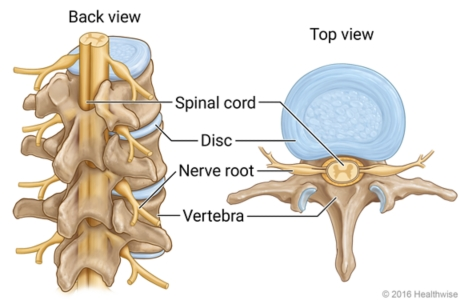“I’ve put my back out” is a common phrase that comes up when you strain your back. The excruciating pain, discomfort, lop-sidedness, loss of range of motion all make you think that your back has popped out of alignment and needs to be popped back in. This is not entirely true and is a common misconception.
When you are injured, the words used to describe your situation can affect your perception of how to manage your back pain. Saying that you “put your back out” will give you the impression that your spine needs to be clicked back into place or some quick means of treatment will fix it once and for all. Understanding that your back is complex with many structures that could be contributing to your pain allows for you to know that it may take a varied approach to treatment and a varied timeline to get some good results.
When you strain your back there are a myriad of physical factors causing your pain depending on what structure in your back/spine is affected. Let me explain spinal anatomy (simply). Your spine is composed of vertebral bodies (bones that form the structure and foundation of the spine), discs (gel-like round cushions of fluid providing shock absorption between the vertebral bodies), facet joints (joints between the vertebrae that control movement in varied directions), nerves branching out from the spinal cord, muscles between and around the vertebrae. Here’s an illustration for all the visual people out there.
From the case history, we get a detailed picture of your injury, the history of your injury, medical history, and the physical/environmental/emotional/psychological factors contributing to your pain. After the case history, you may be asked to do a few movements to determine your range of motion. Osteopaths are trained to do orthopaedic testing such as reflex testing and other specialist tests if necessary, which help with diagnosing the structures in the spine that are affected. The diagnosis could be a facet joint irritation, a muscle spasm or a disc injury to name a few. All these diagnoses mentioned may have varied symptoms of pain during transition movements of sitting to standing, rotating, coughing or sneezing and possibly referral of pain or pins and needles above or below the site of injury.
“Everything in your body is intrinsically connected”, said the osteopath in every osteo appointment! Treating only the spine with a click “back into place” or just treating the muscles may not help the situation. Our bodies and nervous system are pretty clever in responding to pain. To reduce compression on the disc or on a spinal nerve the body moves away from the site of injury. Osteopaths would treat the injury by getting more space between the facet joints, releasing and relaxing the associated muscles, settling down the nervous system and encouraging more blood flow to the area. The bigger picture of seeing the body as a whole would include the osteopath being aware of the organs related to the particular spinal region, fascial tension and compromise to the structures above and below the site of injury. This wide lens that we as osteopaths use, allows for tailored treatment using various techniques, advice on stretches and exercises and a better management plan so you can get back to doing what you love.
Having back pain is not fun and we as osteopaths understand this. Getting the right care early on can help the outcome of your injury and provide a whole new perception of your pain. Your body is an intelligent ecosystem where the musculoskeletal system, nervous system, blood and lymphatic system, and organs all talk to each other. Your body expressing pain shows that your system knows when to tell you that something is wrong. Alarm signals of pain allow you to take action and seek help. Your back is not “dumb” for getting injured.
Helping you to re-frame your thoughts of pain and understanding where your pain is coming from can empower you as a patient on your health journey.
If you have pain, taking action is key. Contact us today, to see how we can help you!

